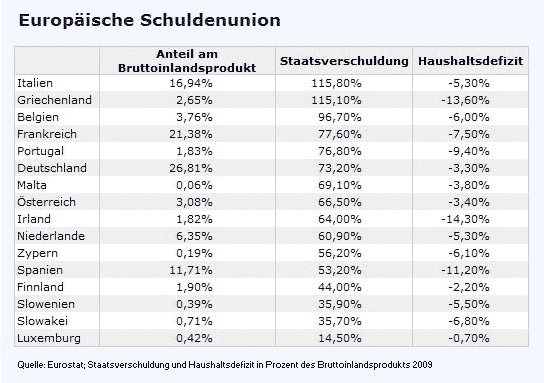Stat of the Day: Table of euro-zone debt and deficits
Below is a table of all the Eurozone debt and deficit figures for 2009. The chart is in German from the Frankfurter Allgemeine newspaper, but I think the country names are clear except Österreich, which is German for Austria. The column headers are percentage of eurozone GDP, gross debt to GDP levels and federal budget deficits as a percent of GDP.
Notice how only six countries – including Spain as the only large country – meet the Maastricht 60% debt-to-GDP criteria. Germany and France do not. Also notice that only Finland and Luxembourg meet the 3% deficit hurdle.
Source
Mehr als nur eine Abwertung – Frankfurter Allgemeine

Crux of the problem right there. The Germans fought to embed fiscal constraints into the Euro, then were the first to infringe the rules (Danke schön Herr Schröder). They’ve been more virtuous since then but the institutional damage was done almost right after the Euro had been launched. Look at the news coverage back circa 2004. What a lack of vision.
EU/IMF say Greece can be contained thanks to bund rates (vs. junk credit card rates). So far and in the short term, German bond yield is dropping, great maybe we can have a free lunch (hey we’ll make money on the spread to 5%!). But if “contagion” happens (that is, if bond markets open their eyes and make the proper diagnosis since the patients have been sick all along), who says Germany won’t converge instead towards Greek rates? Are the US and Japan really credible IMF backers for a $500B line of credit, given the state of their own finances? There’s Greece contributing money to the new IMF money pot for chrissakes. So debt is going to be repaid with debt? This looks more and more like the US Fed putting GSEs on its balance sheet so we can pretend that treasuries and ibanks are not bankrupt.
And pretend they did and so has everybody else, and its worked fine till now!
What I would like to see is a table which also includes private debt: consumer, mortgages, corporate & financial. Or are you suggesting that there is smthg different with private debt that makes it benign?